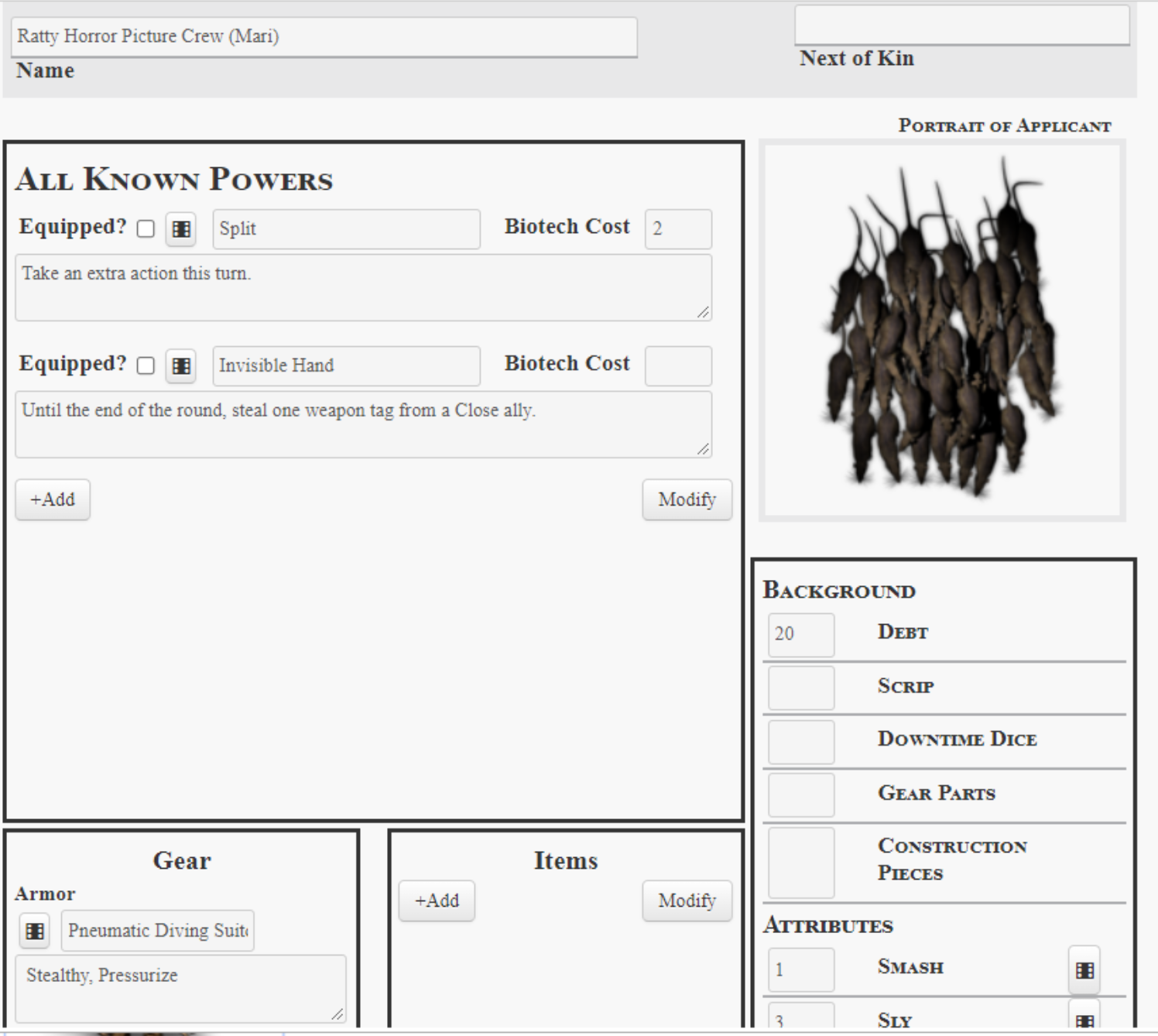Overview
I recently made a Roll20 character sheet for Cyberrats. This was my second time making a Roll20 character sheet (though the first was 5 years ago).
It took me around 60 hours to make the Cyberrats character sheet, though it’s more complex than most. My goal with this guide is to help you make your next character sheet (whether it’s your first or your fifth) in a fraction of that time.
 A small preview of the first page of the Cyberrats character sheet on Roll20.
A small preview of the first page of the Cyberrats character sheet on Roll20.
You can find all of the code for this character sheet on Github, though jumping in to it directly is probably overwhelming.
Note on costs: There is no way to develop or test a Roll20 Character sheet without a Pro account, the subscription for which currently costs around $10 / month. If you aren’t a regular subscriber, I recommend grabbing a month when you’ll have time to iterate quickly. While you can do a lot of rough layout in HTML alone, it’s really beneficial to load everything up in their environment.
This Guide
This guide is a series of tutorials split into 12 sessions. You are in session 0, which is The Overview. As I write other sections, I will link to them here.
The sessions are as follows:
Session 0. Overview
Session 1. Crash Course on HTML
Session 2. Basic CSS and Styling
Session 3. Getting started with Roll20 (Tutorial starts here!)
Session 4. Putting it All Together
Session 5. Filling It In (With Flex)
Session 6. The Body
Session 7. Advanced CSS
Session 8. JavaScript Overview
Session 9. Reacting in Roll20 With JavaScript
Session 10. Roll Templates
Session 11. Advanced Tips and Tricks
Session 12. Making it Official (and Available)
Sessions 1 and 2 are high-level overviews of their respective technologies. In sessions 3 and 4 we’ll actually start building a basic character sheet, and the rest of the sessions will teach you techniques to make those sheets interactive, stylish, and all-around better.
Tip: If this is still overwhelming, or you don’t have the time to learn all of this, you can hire me to make a character sheet for you. Find my contact information in the sidebar. Rates vary with the complexity of the sheet.
Tools
Roll20 character sheets are built using the same tools as most web sites: HTML, CSS, and JavaScript.
HTML is used to determine the structure of your page (how the sheet is laid out), CSS determines the style of those elements (how the page, and the elements on it, look). JavaScript is used for interaction (when the user clicks on a button, do something).
Note: While proficiency with these three technologies is useful, it is not required. My goal is for these tutorials to be accessible to anyone, regardless of experience.
That said, the less experience you have, the longer it will take you. I am fairly experienced with many of these technologies, and it took me around 60 hours to make the character sheet for Cyberrats. It’s on the complex end, as far as character sheets go. Some of that time was spent learning new things, which I’m hoping to share with you through these posts.
It is likely that you will have to trade complexity for time.
I’ll talk more about these technologies later on, in their own sessions, as well as how we use them, but the overview about should give you the general idea of what they do.
Technology
As an aside, all of these files are just text files with different file extensions. HTML files end in .html; CSS files end in .CSS; and JavaScript files end in .js. You can edit these files in a text editor like Notepad, but I strongly recommend downloading a more powerful (and free!) text editor like Notepad++ or VSCode.
These text editors can provide color-coding of certain words (called Syntax highlighting), auto-complete opening HTML tags with closing ones, and provide many other tools that will improve your quality of life.
 HTML Code in Notepad++ with syntax highlighting. When I click “Textarea”, the matching close tag is highlighted.
HTML Code in Notepad++ with syntax highlighting. When I click “Textarea”, the matching close tag is highlighted.
You can open your HTML files either with your text editor, for editing, or with your favorite web browser to see how it looks.
Let’s jump into Section 1, where I cover the basic building tools of HTML. You’ll use those to build the skeleton of your character sheet.